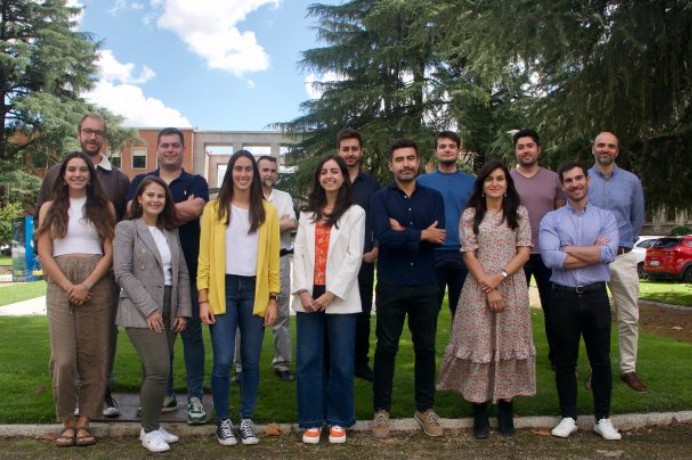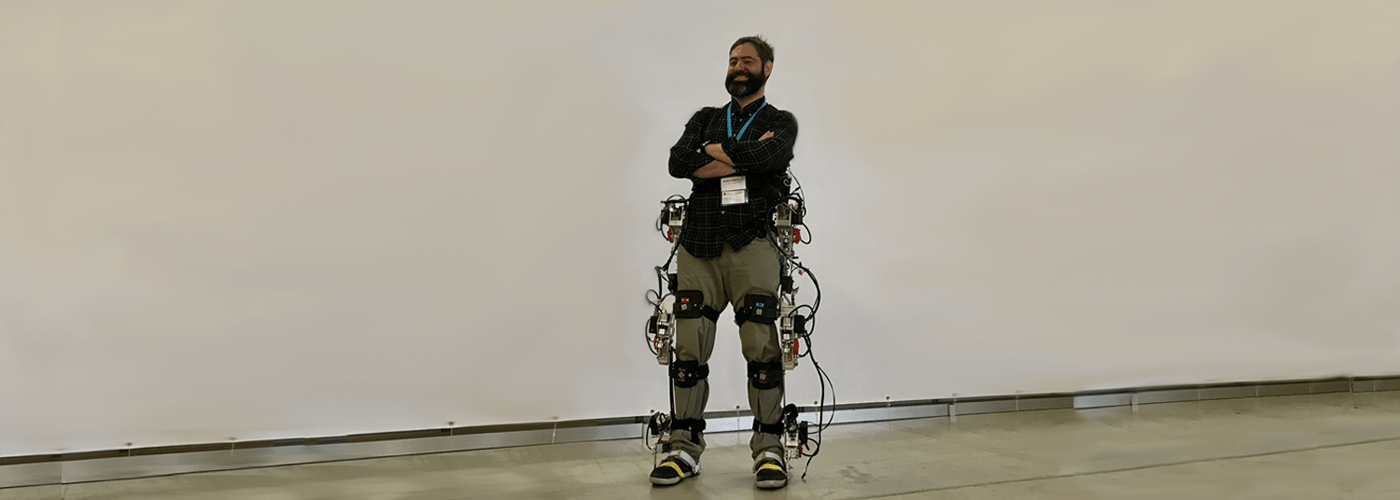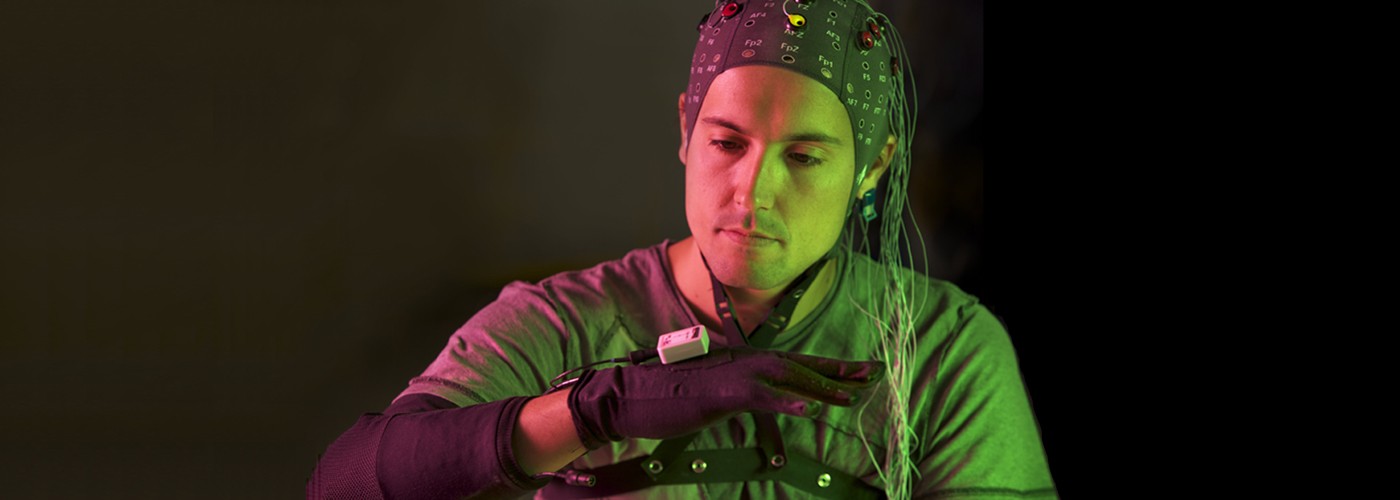LABORATORIES
Neural Rehabilitation Group
Neural Rehabilitation Group
Research
Team
Publications
Contact
Others
Research
In the Neural Rehabilitation Group (NRG) we focus our main research efforts to develop methods and technologies that could help understanding and controlling human biological systems and their interaction with the environment. In particular, interdisciplinary research program is established with the mission of collaboratively pursuing the development of innovative methodologies, interventions, and assistive devices to improve the quality of care and quality of life for people with disabilities.
In this context, our goals cover the analysis and evaluation of the neuromusculoskeletal and cognitive systems that allow humans to produce movement and decisions in unstructured environments. We actively pursue innovative and impactful research toward the development of methods that improve functional or health outcomes of individuals with physical disabilities, including but not limited to individuals with stroke, spinal cord injury, cerebral palsy. In addition, we are interested on cognitive and physical human enhancement through natural or artificial means.
Visit our webiste: https://www.neuralrehabilitation.org/en/

Lines of investigation
Impaired motor function is a hallmark feature of neurological conditions such as spinal cord injury, stroke, Parkinson’s Disease and multiple sclerosis, as well as aging. The resulting decreased mobility very often leads to social stigma and increased rates of depression, having an important impact on patient’s quality of life, with subsequent considerable costs for health and social services.
1. Rehabilitation robotics
The main goal of this research line is to improve the quality of life of individuals with movement disorders by developing and evaluating breakthrough robotic technologies, including exoskeletons, exosuits and assistive robots, and interventions able to: i) promote recovery of lost motor functions, and/or ii) assist the activities of daily living. To achieve our goal, we take a multidisciplinary approach focused on the fields of mechatronics and control, driven by the research in the fields of neurorehabilitation, neurophysiology and biomechanics. We design technologies and interventions based on the latest scientific evidence combined with feedback received from end-users, which includes stroke, spinal cord injury, multiple sclerosis and Parkinson’s Disease patients, as well as elderly users.
History/expertise of the group in this line: The group maintains a close collaboration with several rehabilitation hospitals and patient associations, including the National Spinal Cord Injury Hospital, Hospital los Madroños, Madrid’s Parkinson association. Besides, the group has experience in transferring the conducted research and technologies to spin-off companies, such as Technaid (https://www.technaid.com/), resulting in commercial products, such as the H3 lower limb exoskeleton.
Related Projects: Since 2008 the group has participated in, and led, multiple research projects in the wearable robotics field, both at national and international levels. Some examples are: the RehAnkle project, focused on developing a new smart robot for ankle rehabilitation; the Nimble project, focused on assessing and improving current exoskeletons for gait rehabilitation; the Tailor project, focused on delivering affordable and personalized wearable technologies for neurologically impaired users; the SmartWearable project, focused on improving the accuracy, robustness and safety of the robotic-assisted rehabilitation process of the knee and ankle joints; or the BioMot project, focused on improving the symbiotic interaction of humans with wearable robots.
Relevant papers:
- Sanchez-Villamañan, M. D. C., Gonzalez-Vargas, J., Torricelli, D., Moreno, J. C., & Pons, J. L. (2019). Compliant lower limb exoskeletons: a comprehensive review on mechanical design principles. Journal of neuroengineering and rehabilitation, 16(1), 1-16.
- Pinto-Fernandez, D., Torricelli, D., del Carmen Sanchez-Villamanan, M., Aller, F., Mombaur, K., Conti, R., … & Pons, J. L. (2020). Performance evaluation of lower limb exoskeletons: a systematic review. IEEE Transactions on Neural Systems and Rehabilitation Engineering, 28(7), 1573-1583.
- Massardi, S., Rodriguez-Cianca, D., Pinto-Fernandez, D., Moreno, J. C., Lancini, M., & Torricelli, D. (2022). Characterization and evaluation of human–exoskeleton interaction dynamics: a review. Sensors, 22(11), 3993.
- Asín-Prieto, G., Mercante, S., Rojas, R., Navas, M., Gomez, D., Toledo, M., … & Moreno, J. C. (2022). Post-stroke rehabilitation of the ankle joint with a low cost monoarticular ankle robotic exoskeleton: Preliminary results. Frontiers in Bioengineering and Biotechnology, 10.
- Bortole, M., Venkatakrishnan, A., Zhu, F., Moreno, J. C., Francisco, G. E., Pons, J. L., & Contreras-Vidal, J. L. (2015). The H2 robotic exoskeleton for gait rehabilitation after stroke: early findings from a clinical study. Journal of neuroengineering and rehabilitation, 12, 1-14.

2. Neural Interfaces
Neural information can be used to drive prosthetic devices or directly stimulate nerves / muscles. These neural interfaces are aimed at restoring or augmenting lost sensory-motor functions in humans. This means building a connection of technology with biology to replicate and restore the human natural sensory-motor control loop. On top of that, physiological theories are needed to explain, predict and control such loop. Current challenges in the field involve decoding impaired neural information and acting accordingly to restore / assist weakened or partially lost movements using minimally invasive interfaces.
History/expertise of the group in this line: Since 2018, our team is in the unique position to study and apply neural engineering techniques (such as neuroprostheses) in essential tremor and Parkinson’s disease patients . We have run dozens of experiments as part of a collaborative work with Dr. Francisco Grandas (who leads the Movement Disorders Unit at Gregorio Marañón General University Hospital), in the framework of the EXTEND and AI4HA projects.
Related Projects: Our lab also studies how humans react to personalized fusion of electrical and robotic assistance and other multisensory signals for feedback. Since 2010 we have had a sustained cooperation to explore such fusion of neuromuscular and spinal stimulation with robotics to restore function in patients with spinal cord lesions under the Associated Unit ‘Neurorehabilitation, Biomechanics and Sensorimotor Function’ of the National Spinal Cord Injury Hospital to the Cajal Institute. With this approach we have demonstrated how hybrid approaches can provide personalized assistance to improve the motion patterns in neurological patients. In this line we also have explored diverse techniques to assess different levels of human response using biomechanical, physiological, brain recordings and subjective ratings to analyze usability of new neural technologies.
Relevant papers:
- Pascual-Valdunciel, A., González-Sánchez, M., Muceli, S., Adán-Barrientos, B., Escobar-Segura, V., Pérez-Sánchez, J. R., … & Barroso, F. O. (2020). Intramuscular stimulation of muscle afferents attains prolonged tremor reduction in essential tremor patients. IEEE Transactions on Biomedical Engineering, 68(6), 1768-1776.
- Pascual Valdunciel, A., Kurukuti, N. M., Montero Pardo, C., Barroso, F. O., & Pons, J. L. (2022). Modulation of spinal circuits following phase-dependent electrical stimulation of afferent pathways. Journal of Neural Engineering.
- J-del-Ama, A., Comino-Suarez, N., Martinez-Martin, J., Gil-Agudo, Á., Moreno, J. C., & Spaich, E. G. (2022). Pilot study on the combination of robotic gait training with stimulation of the withdrawal reflex in patients with spinal cord injury. Artificial Organs, 46(3), E103-E105.
- Del-Ama, A. J., Gil-Agudo, Á., Pons, J. L., & Moreno, J. C. (2014). Hybrid FES-robot cooperative control of ambulatory gait rehabilitation exoskeleton. Journal of neuroengineering and rehabilitation, 11(1), 1-15.
- Pascual-Valdunciel, A., Hoo, G. W., Avrillon, S., Barroso, F. O., Goldman, J. G., Hernandez-Pavon, J. C., & Pons, J. L. (2021). Peripheral electrical stimulation to reduce pathological tremor: a review. Journal of neuroengineering and rehabilitation, 18(1), 1-19.
3. Benchmarking
Benchmarking is the process of comparing the performance of a given system or process against a set of standards or a comparable system. Benchmarking requires a set of metrics that can accurately reflect the capabilities and potential of the system under examination. In rehabilitation robotics, common metrics are accuracy, speed, stability, power, weight, energy consumption, range of motion, donning and doffing time, user comfort, etc… The results of the benchmarking analysis can be used to set performance targets, improve the efficiency of R&D processes, predict the effects of different solutions, or verify safety. Particularly important in benchmarking are unified datasets and standard experimental protocols to compare systems on a common ground of tasks and domains. Benchmarking is normally conducted in the laboratory to assure measurability and reproducibility. However, lab tests should be complemented by field tests to verify the ability of benchmarks to predict real world performance.
History/expertise of the group in this line: In our group, we apply benchmarking in two main areas:
· Human locomotion. Our goal here is to characterize bipedal locomotion over a wide range of terrain conditions. Our method is to design specific testbeds and protocols that can reproduce natural-like environments and create large datasets on humans (both healthy and patients) moving in such environments.
· Human-exoskeleton interaction. Our goal here is to assess and predict the transmission of forces between an exoskeleton and an individual during a wide range of operative conditions. Our method is based on the use of physical replicas of human body (test dummies) in combination with digital twins.
Related Projects: The group has coordinated different European projects in this field. In the EUROBENCH Project, we developed the first benchmarking framework for bipedal systems, including exoskeleton, prostheses and humanoid robots, and built the first testing facilities for these types of technologies. In the EXOSAFE and SALOEXO projects, we explored the physical interactions between humans and exoskeletons, developing methodologies to test the transmission of forces by using physical replicas of the human limbs and AI methods to predict user’s comfort. The group has extended these benchmarking approaches in the field of Parkinson’s Disease diagnosis, with two national projects, NEUROMARK and AI 4 HEALTHY AGING. The basic idea behind them is to assess the motor activity of patients under a multidimensional perspective, by exposing them to multiple motor tasks under different challenging conditions, using AI to identify good biomarkers of the evolution of symptoms.
Relevant papers:
- Torres-Pardo et al., Legged locomotion over irregular terrains: state of the art of human and robot performance, Bioinspiration & Biomimetics, 2022. 4.
- Longatelli et al., A unified scheme for the benchmarking of upper limb functions in neurological disorders, Journal of NeuroEngineering and Rehabilitation 19(1): pp 1-20, 2022. 2.
- Remazeilles et al. Making Bipedal Robot Experiments Reproducible and Comparable: The Eurobench Software Approach, Frontiers in Robotics and AI, 2022. 7.
- Torricelli et al., Benchmarking Wearable Robots: Challenges and Recommendations From Functional, User Experience, and Methodological Perspectives. Frontiers in Robotics and AI. 7. 168. 2020
- Pinto-Fernández et al., Performance evaluation of lower limb exoskeletons: a systematic review. IEEE Transactions on Neural Systems and Rehabilitation Engineering. 28. 7. 1573-1583. 2020
- Torricelli et al., A subject-specific kinematic model to predict human motion in exoskeleton-assisted gait. Front. Neurorobot.. 2018. 10.3389/fnbot.2018.00018.
- Torricelli et al., “Benchmarking Bipedal Locomotion: A Unified Scheme for Humanoids, Wearable Robots, and Humans,” in IEEE Robotics & Automation Magazine, vol. 22, no. 3, pp. 103-115, Sept. 2015, doi: 10.1109/MRA.2015.2448278.

4. AI for Neuroengineering
Definition of the line: Artificial intelligence (AI) has revolutionized the field of neuroengineering by helping to unveil and better understand the mechanisms of brain function and dysfunction. The study of brain dysfunction and the use of AI have contributed to a better comprehension of neurological disorders having a significant impact on diagnostic, evaluation, and rehabilitation procedures, and enhancing and complementing the existing clinical procedures. The main research focus of the group is to use AI techniques for understanding the dysfunctional, motor and non-motor manifestations caused by pathological conditions such as Parkinson’s disease, Alzheimer’s, essential tremor, etc. This is achieved through the analysis of various biosignals, including sEMG, trajectory/ acceleration data recorded from MOCAP systems, speech, and oculometric recodings. Subsequently, AI methodologies are employed to extract novel biomarkers, and to uncover and comprehend the functional differences between pathological and normal conditions.
History/expertise of the group in this line: The group is composed of experts in different fields including signal processing, bioengineering, biomechanics and artificial intelligence. This expertise is complemented by active collaboration with hospitals and clinical centers in Spain, including Hospital General Universitario Gregorio Marañón, Hospital Nacional de Parapléjicos de Toledo and Hospital los Madroños, as well as with other multidisciplinary research groups around the world.
Related projects: The group is currently involved in the AI4HealthyAging project and Neuromark projects, in which we develop and use AI models to study motor-related manifestations of Parkinson’s disease using several biometric approaches. We are particularly interested in studying the progression of the disease with time , and to fuse the different recording modalities to improve the understanding of PD manifestations in a holistic way..
Relevant papers:
- Pascual-Valdunciel, Alejandro, et al. “Classification of Kinematic and Electromyographic Signals Associated with Pathological Tremor Using Machine and Deep Learning.” Entropy 25.1 (2023): 114.
- Pascual-Valdunciel, Alejandro, et al. “Prediction of Pathological Tremor Signals Using Long Short-Term Memory Neural Networks.” IEEE Journal of Biomedical and Health Informatics 26.12 (2022): 5930-5941.
- Cermeno-Silveira, C., et al. “Detecting Parkinson’s Disease from body limb acceleration using machine learning and a frequency-domain analysis.” MOVEMENT DISORDERS. Vol. 37. 111 RIVER ST, HOBOKEN 07030-5774, NJ USA: WILEY, 2022.
- Perez Sanchez, J. R., et al. “IMU-based study on Gait and Balance in Parkinson’s disease and healthy subjects.” MOVEMENT DISORDERS. Vol. 35. 111 RIVER ST, HOBOKEN 07030-5774, NJ USA: WILEY, 2020.
- Caramia, Carlotta, et al. “IMU-based classification of Parkinson’s disease from gait: A sensitivity analysis on sensor location and feature selection.” IEEE journal of biomedical and health informatics 22.6 (2018): 1765-1774.
5. Neuroscience-inspired AI and Robotics
This research line focuses on understanding how humans perceive and act with their body to i) improve artificial intelligence and robotic systems, and at the same time ii) aid to unveil the inner mechanisms of information processing in the brain. We develop novel algorithms for learning, estimation and control of complex systems based on neuroscience findings and evaluate them in robotic platforms (humanoids, manipulators). Our models, besides being relevant for disciplines, such as computational neuroscience, robotics and cognitive science, are particularly interesting for human-centric solutions, e.g., healthcare, human-robot interaction, wearable robotics, etc. In the long run, this research pursues achieving robots with human comparable embodied intelligence. Enabling robots to act and adapt to real-world complex interactions is one of the key challenges of this century.
History/expertise of the group in this line: We have more than ten years of experience in brain-inspired machine learning models for robot perception and action. We pioneered the successful deployment of neuroscience-inspired models (e.g., predictive coding) in humanoid robots as well as replicating human perceptual experiments in robotics systems (e.g., rubber-hand illusion). We are internationally recognized for the active inference approach to robotics, a neuroscience-inspired framework that describes the brain as an inference machine. We are currently investigating new theoretical probabilistic models for practical applications in industrial robotics, environmental monitoring and healthcare. Our research includes:
- Neuroscience-inspired Artificial Intelligence (NAI).
o Variational Inference, (Deep) active inference.
o On-chip spiking neural networks control.
- Embodied intelligence: Robot learning, estimation and control
- Computational models of human body perception and action
- Self-perception, awareness and synthetic consciousness.
Related Projects:
- METATOOL. (Pathfinder challenge EIC) www.metatool-project.eu
- SPIKEFERENCE (Human Brain Project EU SGA3) www.spikeference.eu
- DEEPSELF (German Research Foundation) https://gepris.dfg.de/gepris/projekt/467045002?language=en
- SELFCEPTION (MSCA EU) www.selfception.eu
Relevant papers:
- Lanillos, P. et al (2021). Active inference in robotics and artificial agents: Survey and challenges. arXiv preprint arXiv:2112.01871.
- Lanillos, P., Franklin, S., Maselli, A., & Franklin, D. W. (2021). Active strategies for multisensory conflict suppression in the virtual hand illusion. Scientific Reports, 11(1), 22844.
- Lanillos, P., & Cheng, G. (2018). Adaptive robot body learning and estimation through predictive coding. IEEE/RSJ Int. Conf. on Inte. Robots and Syst. (IROS) (pp. 4083-4090).
Personal
Group leaders:
Postdocs:
Luis J. Barrios Bravo (Senior Scientist)
Pablo Lanillos (Ramón y Cajal Post-doctoral Researcher)
Filipe Andre Oliveira Barroso (Juan de la Cierva Post-doctoral Researcher)
Jorge A. Gómez García (Post-doctoral Researcher)
David Rodriguez Cianca (Juan de la Cierva Post-doctoral Researcher)
Clara Sanz Morere (Juan de la Cierva Post-doctoral Researcher)
PhD Students:
Marina Algaba Vidoy
Noemi Lois
Stefano Massardi
Adriana Torres Pardo
Sara Ruiz Diez
Technical Staff:
Sara González
Tania Olmo Fajardo
Paulino Sendin Valiente
Research manager:
Pilar Raya López
Publications
Visit our website: https://www.neuralrehabilitation.org/en/?page_id=13
Contact
Where to find us
Neural Rehabilitation Group
Instituto Cajal CSIC. Avda. Doctor Arce, 37. 28002. Madrid
Call us
Write us
Email address:
Otros
Visit our website: https://www.neuralrehabilitation.org/en/?page_id=13

Neuroscience Research Center dependent on the CSIC. Founded in 1920 and initially directed by Santiago Ramón y Cajal. World reference in the study of the brain. Custodian of the Cajal Legacy.
Activities
